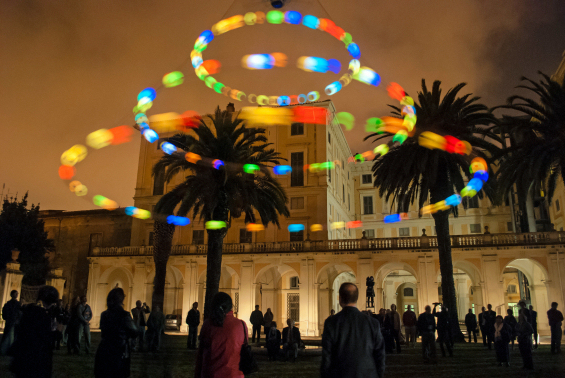New artwork unveiled at the Science with the Hubble Space Telescope IV conference [heic1407]
25 March 2014
Last week researchers from around the world gathered at the Accademia dei Lincei in Rome for the Science with the Hubble Space Telescope IV conference. The event celebrated the history of Hubble's extraordinary achievements, and looked to the future at what might yet be achieved and how the James Webb Space Telescope will build on our knowledge of the Universe. As part of this celebration artist Tim Otto Roth revealed a new artwork, Heaven's Carousel, inspired by Hubble's work on the accelerating expansion of the Universe.The artwork takes the form of a rotating carousel, with 36 illuminated spherical loudspeakers mounted on long strings and illustrates some of Hubble's key findings and the physical processes that underpin Hubble's work [1].
"Being inside the installation is like being inside a sound Universe," says artist Tim Otto Roth. "When you look up at the night sky you see it in black and white, but in reality it is full of colours, colours which are too faint to be perceived by the eye's colour receptors. It is the most dominant of these colours that I have translated into sound as part of the Heaven's Carousel."
In representing the Universe in this way Heaven's Carousel allows the audience to experience phenomena such as the Doppler effect [2]. This phenomenon has been key to many of the discoveries discussed at the conference as it lets us know just how fast the galaxies observed by Hubble are moving away from or towards us. This can be experienced within the sound installation where at the centre of the installation there is no significant effect, but as the visitor moves outwards the frequencies start to oscillate dramatically and weave into a mesmerising sound tapestry.
During the 25-minute sound performance the other phenomena and processes that inspired the piece become evident. For example the progress from the high pitched and bright blue tones that represent the beginning of the Universe to the deep tones of red and low frequency sounds that illustrate what we observe in the distant Universe with Hubble today.
The premiere on Monday 17 March was very well attended and speeches were given by Tim Otto Roth and Adam Reiss, Nobel Prize winner and advisor to the artist, whose work was crucial to showing that the expansion of the Universe is accelerating.
The immersive installation shows another way that Hubble has inspired new thinking over its 24 years in orbit. It provided the perfect accompaniment to the conference, which involved four days of talks from fields as broad as dark energy, the Hubble Frontier Fields, exoplanet research and Solar System research, to name but a few.
"As we celebrate Hubble's splendid 24 years in orbit" says ESA Hubble Space Telescope project scientist Antonella Nota. "We are left to marvel at the accomplishments humanity can achieve when there is collaboration between communities. On this occasion, we celebrate the partnership between NASA and ESA which led to the creation of Hubble. A partnership which set the foundation for the James Webb Space Telescope and many more ventures to come."
Hubble has allowed us to peer into the ancient Universe, to find planets outside the Solar System, to map the dark matter that lurks within galaxy clusters and to say that the expansion of the Universe is accelerating. In the words of John Grunsfeld, NASA Associate Administrator and former astronaut, who has visited Hubble on three occasions: "Hubble has taken us further than we knew possible towards answering the biggest questions humanity has ever thought to ask: Where did we come from? Where are we going? And, are we alone?"
As part of the conference John Grunsfeld gave a talk on his experience of the Hubble service missions. These missions not only kept Hubble alive, but have also given Hubble a new lease of life through the installation of the wide-field camera, WFC3, on this last mission. This new camera is part of the reason that Hubble is still in constant use and a major theme of the conference was where Hubble will take us next. It is clear that, even with the James Webb Space Telescope on the horizon, Hubble still has a great deal left to offer.
Notes
[1] Heaven's Carousel is Roth's second major cooperation with Hubble astrophysicists following From the Distant Past, which translated Hubble spectral data into animated laser projections onto prominent façades in Venice, Baltimore and the heart of New York City. To see more of this art installation, see Hubblecast 63: From the distant past – Hubble and art.
[2] The Doppler effect is key to many of Hubble's observations, it means that objects travelling towards us have their light waves compressed – so we see them as bluer in colour – and those moving away have their light waves expanded so that we see them in a redder colour, or "redshifted" as it is more commonly known.
More information
The conference was sponsored by ESA and NASA, and organised by ESA, STScI, and INAF-IAPS.
The Hubble Space Telescope is a project of international cooperation between ESA and NASA.
Contacts
Tim Otto Roth
Email: assistant![]() imachination.net
imachination.net
Elisa Costa
Goethe-Institut
Rome, Italy
Tel: +39 06 844 00 51
Email: costa![]() rom.goethe.org
rom.goethe.org
Georgia Bladon
Hubble/ESA
Garching bei München, Germany
Tel: +49-89-3200-6855
Email: gbladon![]() partner.eso.org
partner.eso.org



